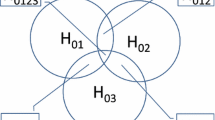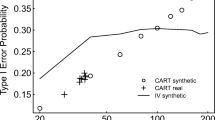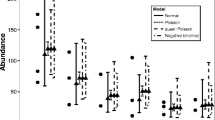Abstract
In ecotoxicology species reproduction tests and multiple testing of reproduction data are wide spread. While normal approximation of the data is a minor problem often the requirement of variance homogeneity is not fulfilled. Variance homogeneity is necessary to assure the proper application of statistical procedures like pairwise t tests, Dunnett t test, and Williams t test. A Poisson model can solve this issue preserving meaningful results and rendering statistical analysis more reliable. Moreover, sequential application of pairwise statistical “control vs. treatment” tests is a drawback concerning \(\alpha \)-inflation. The closure principle (CP) for hypothesis testing is used to generate a step-wise approach for detection of the No/Lowest Observed Effect Concentration using the computational approach test (CAT). The advantages and disadvantages of the combined CPCAT approach compared to the widely used t tests are pointed out and results of real data and fictitious data analysis are compared revealing the superiority of the Poisson model and CPCAT.









Similar content being viewed by others
References
Bretz F, Hothorn T, Westfall P et al (2011) Multiple comparisons using R. CRC Press, Boca Raton
Carrasco IJ, Chang S-Y (2005) Random monte carlo simulation analysis and risk assessment for ammonia concentrations in wastewater effluent disposal. Stoch Environ Res Risk Assess 19:134–145
Chang C-H, Pal N, Lin J-J (2010) A note on comparing several poisson means. Commun Stat Simul Comput 39:1605–1627
Chapman PF, Crane M, Wiles J, Noppert F, McIndoe E (1996) Improving the quality of statistics in regulatory ecotoxicity tests. Ecotoxicology 5:169–186
Chiu SN (2010) Parametric bootstrap and approximate tests for two poisson variates. J Stat Comput Simul 80:263–271
Chiu SN, Wang L (2009) Homogeneity tests for several poisson populations. Comput Stat Data Anal 53:4266–4278
Delignette-Muller ML, Lopes C, Veber P, Charles S (2014) Statistical handling of reproduction data for exposure-response modeling. Environ Sci Technol 48(13):7544–7551
Drew JH, Evans DL, Glen AG, Leemis L (2008) Computational probability: algorithms and applications in the mathematical sciences. Springer, New York
Dudley RM (2014) Uniform central limit theorems. Cambridge University Press, Cambridge
Dunnett CW (1955) A multiple comparison procedure for comparing several treatments with a control. J Am Stat Assoc 50:1096–1121
Dunnett CW (1964) New tables for multiple comparisons with a control. Biometrics 20:482–491
Fahd F, Khan F, Hawboldt K, Abbassi R (2014) Developing a novel methodology for ecological risk assessment of thiosalts. Stoch Environ Res Risk Assess 28:383–391
Gopi RA, Ayyappan S, Chandrasehar G, Varma KK, Goparaju A (2012) Effect of potassium dichromate on the survival and reproduction of daphnia magna. Bull Environ Pharmacol Life Sci 1:89–94
Gupta BC, Guttman I (2014) Statistics and probability with applications for engineers and scientists. Wiley, Hoboken
Holm S (1979) A simple sequentially rejective multiple test procedure. Scand J Stat 6:65–70
Jonckheere AR (1954) A distribution-free k-sample test against ordered alternatives. Biometrika 41:133–145
Krishnamoorthy K, Thomson J (2004) A more powerful test for comparing two poisson means. J Stat Plan Inference 119:23–35
Kruskal WH, Wallis WA (1952) Use of ranks in one-criterion variance analysis. J Am Stat Assoc 47:583–621
Lee H-K, Yeh Y-Y, Chen W-M (2006) Cancer risk analysis and assessment of trihalomethanes in drinking water. Stoch Environ Res Risk Assess 21:1–13
Lehmann EL, Romano JP (2006) Testing statistical hypotheses. Springer, New York
Liu KF-R, Ko C-Y, Fan C, Chen C-W (2013) Incorporating the lcia concept into fuzzy risk assessment as a tool for environmental impact assessment. Stoch Environ Res Risk Assess 27:849–866
Marx, C., Mühlbauer, V., Krebs, P. & Kuehn, V. (2015) Species-related risk assessment of antibiotics using the probability distribution of long-term toxicity data as weighting function: a case study. Stoch Environ Res Risk Assess:1–13. doi:10.1007/s00477-015-1026-4
Ng HKT, Tang ML (2005) Testing the equality of two poisson means using the rate ratio. Stat Med 24:955–965
OECD (1984) Test no. 206: Avian reproduction test. In: OECD guidelines for the testing of chemicals section 2. OECD Publishing, Paris
OECD (2004) Test no. 220: Enchytraeid reproduction test. In: OECD guidelines for the testing of chemicals, section 2. OECD Publishing, Paris
OECD (2006) Test no. 221: Lemna sp. growth inhabition test. In: OECD guidelines for the testing of chemicals, section 2. OECD Publishing, Paris
OECD (2012) Test no. 211: Daphnia magna reproduction test. In: OECD guidelines for the testing of chemicals, section 2. OECD Publishing, Paris
Olofsson P (2013) Probabilities: the little numbers that rule our lives. Wiley, Hoboken
Panjer HH (1981) Recursive evaluation of a family of compound distributions. ASTIN Bull 12:22–26
Przyborowski J, Wilenski H (1940) Homogeneity of results in testing samples from Poisson series. Biometrika 31:313–323
Qin Y, Yang Z, Yang W (2011) Ecological risk assessment for water scarcity in Chinas Yellow River Delta Wetland. Stoch Environ Res Risk Assess 25:697–711
R Development Core Team (2010) R: a language and environment for statistical computing. R Foundation for Statistical Computing, Vienna
Sieratowicz A, Stange D, Schulte-Oehlmann U, Oehlmann J (2011) Reproductive toxicity of bisphenol a and cadmium in Potamopyrgus antipodarum and modulation of bisphenol a effects by different test temperature. Environ Pollut 159:2766–2774
Welch BL (1974) The generalization of ”student’s” problem when several different population variances are involved. Biometrika 34:28–35
Williams DA (1971) A test for differences between treatment means when several dose levels. Biometrics 27:103–117
Williams DA (1972) The comparison of several dose levels with a zero dose control. Biometrics 28:519–531
Acknowledgments
We thank Jörg Oehlmann (Goethe-University Frankfurt, Germany) for providing detailed information concerning snail reproduction after exposure to Cd (data set 5).
Author information
Authors and Affiliations
Corresponding author
Appendix
Appendix
1.1 R-Code: CP

1.2 R-Code: CAT


Rights and permissions
About this article
Cite this article
Lehmann, R., Bachmann, J., Maletzki, D. et al. A new approach to overcome shortcomings with multiple testing of reproduction data in ecotoxicology. Stoch Environ Res Risk Assess 30, 871–882 (2016). https://doi.org/10.1007/s00477-015-1079-4
Published:
Issue Date:
DOI: https://doi.org/10.1007/s00477-015-1079-4




